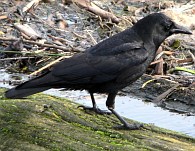2007年VOA标准英语-West Nile Virus Killing Several North American(在线收听)
Washington
16 May 2007
Scientists say West Nile virus is killing large numbers of birds across North America. The organism has devastated big proportions of several bird species that commonly populate town and city suburbs throughout the continent. As we hear from VOA's David McAlary, the finding is a stark example of the potential havoc invasive species can wreak.
Spring in North America has brought the usual seasonal sounds of birds. But this spring, as for the past few years, the sounds of many bird species are fading.
Scientists say the arrival of West Nile Virus in the United States eight years ago has taken a significant toll on seven of 20 bird species whose populations they assessed.
 |
| The American Crow, Corvus brachyrhynchos |
"In some regions, this species decreased up to 45 percent, and that includes routes or locations where the bird decreased closer to 90 percent," noted Shannon LaDeau of the Smithsonian Institution's Migratory Bird Center in Washington. "Crows we definitely knew suffered high mortality when exposed to West Nile Virus, but I still think it was a surprise we were able to show such a large-scale declined in this species across the continent."
In addition to crows, LaDeau and colleagues report in the journal Nature that six other species declined by one-third to two-thirds in some regions. Among them blue jays, the American robin, chickadees, as well as the tufted titmouse, the house wren, and the Eastern bluebird.
"One other surprise that we had was actually the Eastern bluebird, which in the United States is a well-recognized, bright blue bird that suffered pretty significant decline after 2002, which is tightly correlated with when we had human epidemics of West Nile Virus in those same regions," she added.
LaDeau says that of the seven bird species affected, only the blue jay and house wren populations returned to normal by 2005.
She and her colleagues determined the virus' impact on birds by examining bird population surveys going back 26 years. The surveys are conducted by observers along regular North American bird routes.
The researchers say the declines occurred as West Nile Virus moved across the continent and, as in the case of the bluebirds, were geographically highly correlated with the intensity of the disease's transmission in people.
In a Nature magazine podcast, LaDeau says the species were not previously endangered.
"An invasive pathogen [disease] like this can have really important and often devastating impacts on ecosystems that we are not monitoring as endangered ecosystems," she explained. "So in this case, we have several mainland species of very common birds that are not known to be endangered that are really responding quite dramatically to the introduction of this novel pathogen."
LaDeau points out that bird losses can have serious environmental consequences. The decrease in robins has been linked to more mosquitos feeding on people and intensified West Nile Virus epidemics.